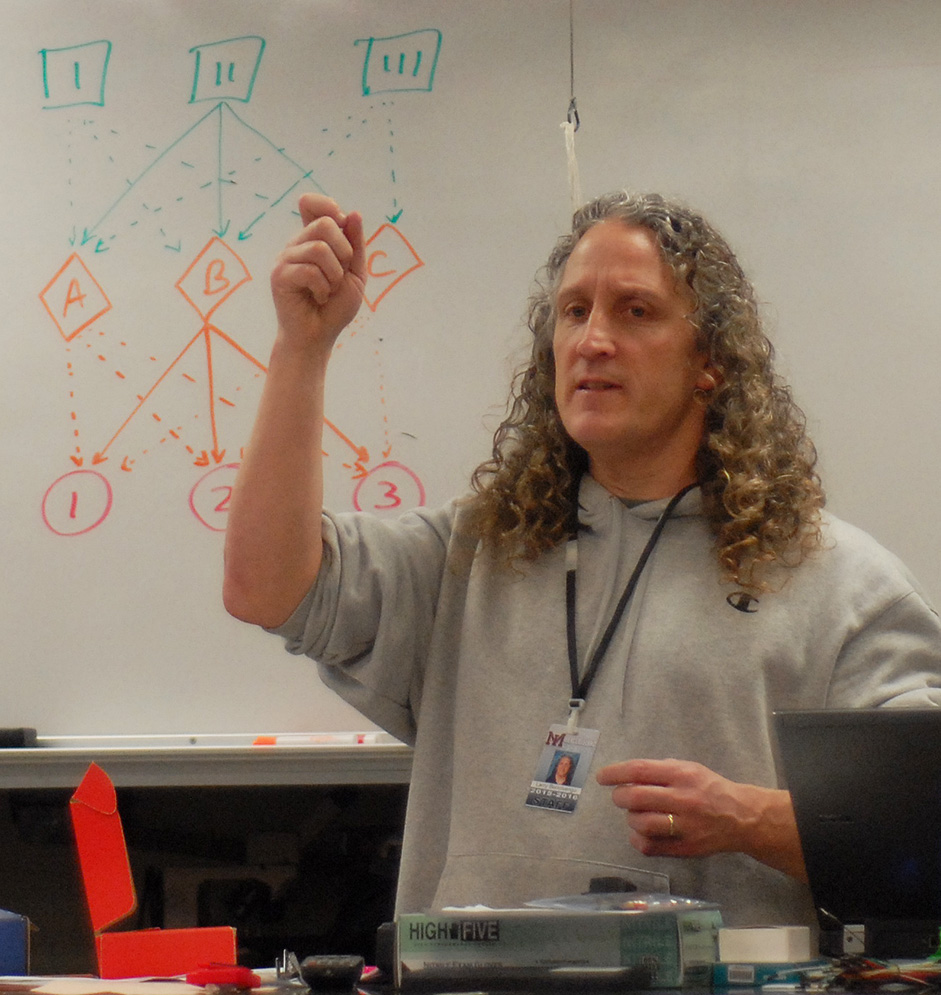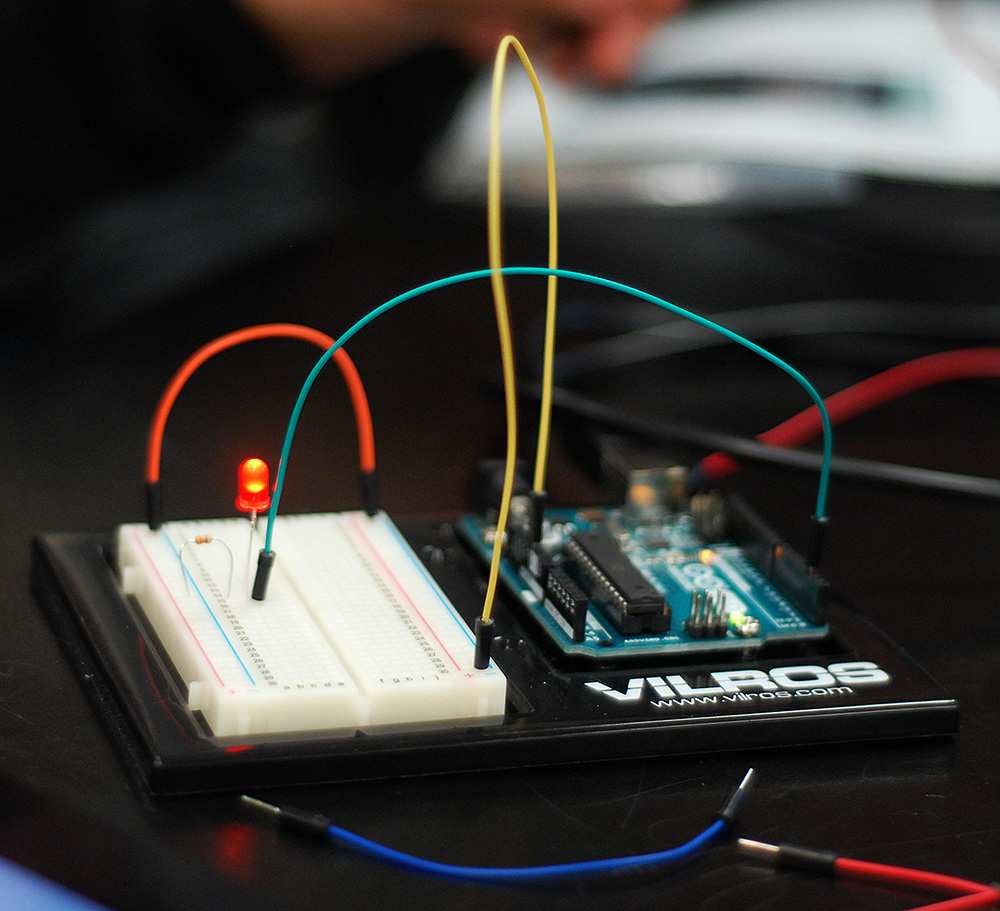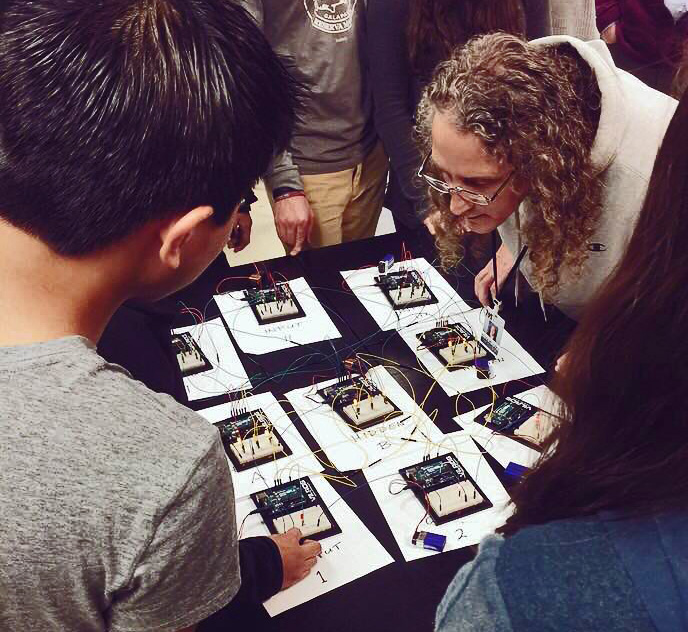Eleanor Cummins
For middle and high school teachers, summers are a time to recharge after a long school year. It can be a rare chance to travel or spend quality time with friends and family.
But for the past four years, a small group of Seattle-area educators have elected to spend their summers on the UW Seattle campus, conducting engineering research in a CNT-affiliated lab and developing a curriculum unit to bring the principles of neural engineering to their students.
Lawrence Bencivengo, Jr. is one such teacher. Bencivengo, who teaches 10th grade biology and AP Biology at Mercer Island High School, participated in the CNT’s Research Experience for Teachers (RET) program in the summer of 2015. In just seven weeks, he not only gained real engineering research experience in the UW BioRobotics Lab of Dr. Howard Chizeck, but he developed a plan to integrate engineering, and the principles of artificial intelligence, into his classroom.

On Wednesday, January 13, Bencivengo debuted his artificial neural network (ANN) to his AP Biology class. The ANN is a collection of networked arduinos, or microcontrollers, that simulate neurons in the brain. When hooked together, the arduinos fire signals in the ANN like neurons fire in the brain. In the brain, these signals result in thoughts, memories, feelings and actions. In the ANN model built by the AP Bio students, the signals result in the output of light. In more complicated networks, the signals could be used in facial recognition software or even a self-driving car.
Bencivengo and his RET partner, Benjamin Hart of Redmond High School, developed the ANN unit as a way to engage students in an engineering design project within a larger lesson on artificial intelligence. Students read about artificial intelligence, neural networks, and other topics in biology and engineering in their textbooks, but the ANN allowed them to assemble a network and test its function.
To assemble the ANN, students had to draw on an interdisciplinary body of knowledge. Bencivengo exposed his students to the basics of neural engineering, as well as familiarized them with some fundamentals of computer programming, even asking them to manipulate a bit of code.

Many of the students in Bencivengo’s class said this tactile experience was unique in their science education. Several students had taken AP Chemistry the year before and said that the course was all notes and rote memorization, while AP Biology with Bencivengo successfully combined book learning with applied practice.
Jennifer Wright, Mercer Island School District’s Director of Learning and Technology Services, agreed. Wright, a former engineer, said applied practice is the key to successful science learning. According to Wright, learning abstract equations can be hard for many students. Understanding how an equation actually relates to real materials, and can generate real solutions to real problems, is the best way to make complex ideas clear.
Unfortunately, Wright said, many teachers don’t have the background in science or engineering needed to make such ideas come alive in the classroom. “Most teachers don’t have the practical experience or theory to hang their lesson on,” Wright said. “But Larry does and he’s constantly pursuing more.”
This lack of research experience among many primary education teachers is complicated by the fact that new education standards now require K-12 educators to incorporate engineering principles into their curriculum.
The new Next Generation Science Standards (NGSS), adopted by Washington State in 2013, asks K-12 science teachers to do just that — transform science instruction into three-dimensional learning by engaging students in core ideas, interdisciplinary concepts, and the practices of real world scientists and engineers.

“This new vision for science education, as laid out in the NGSS, for the first time requires science teachers to bring engineering into their classrooms,” CNT’s Pre-College Education Manager Kristen Bergsman said. Bergsman worked with Bencivengo and Hart to develop their curriculum unit and attended Wednesday’s unveiling of the ANN.
“During our curriculum workshops with the RET participants each summer, we challenge ourselves to develop lesson plans that are deeply aligned with NGSS, that show how contemporary science knowledge is applied by engineers to solve real world problems, and that get students involved in complex engineering design challenges,” Bergsman added. “The RET program gives teachers an amazing opportunity to apprentice into the world of professional engineers and to engage in their own authentic research project, and then they can talk to their students about the practices of engineers as they actually unfolded in their host lab.”
While the RET program allowed Bencivengo new and continued learning opportunities, he was most excited by what he was able to bring home to his students. “Unlike other artificial networks at Facebook or Google, AP Bio’s simple ANN will obviously not be capable of furthering facial recognition software or the technology behind self-driving cars,” he said. “But it will operate using the same basic principles and hopefully help students to develop not only a basic understanding of ANNs, but also a deeper appreciation for how their own brains work.”
